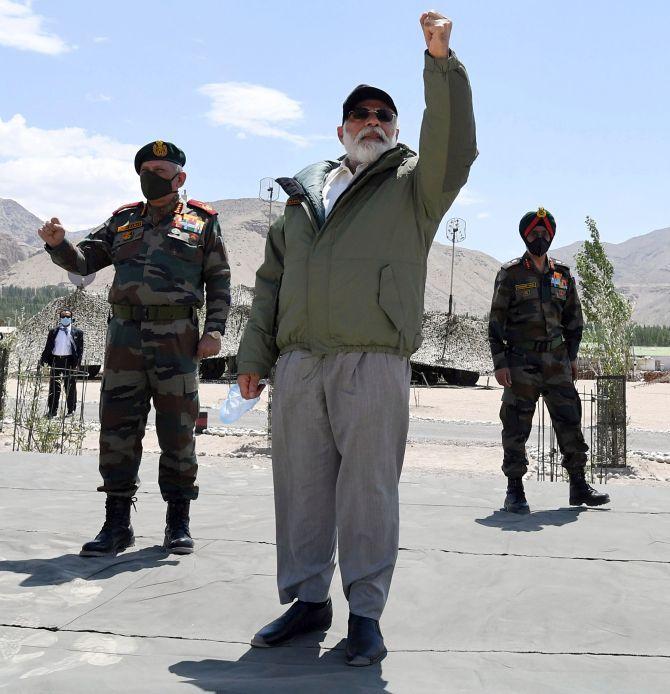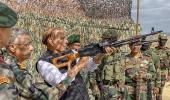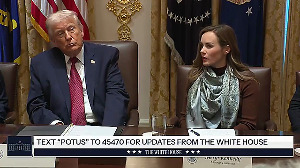It is a constantly evolving situation and will require deft handling at the ground level and at the highest level of military, diplomatic and political leadership, observes Colonel S Dinny (retd), who served as Commanding Officer of an infantry battalion deployed in the Pangong Tso area.

'Truly I tell you, if you have faith as small as a mustard seed, you can say to this mountain, 'Move from here to there,' and it will move. Nothing will be impossible for you' -- Matthew 17:20.
Some in China and a few here in India believe that they can similarly, move the Line of Actual Control too, albeit, through a concerted disinformation campaign.
After failing to foresee the unanticipated and unintended consequences, the Chinese are now desperately attempting to give 'ex post facto strategic meaning', to its actions in Eastern Ladakh.
Unfortunately, some in India are happily playing along.
The campaign from across the border can be understood as part of the well documented, Chinese 'Three Warfare' strategy (external link).
In this, China introduced the concepts of public opinion warfare, psychological warfare, and legal warfare.
The 'media or public opinion' warfare, attempts to shape public opinion both domestically and internationally.
The domestic aspect is also important because the PLA believes in mobilising the Chinese public for projecting resolve and deterring foreign invasions on Chinese interests.
The 'psychological warfare' attempts to influence foreign decision-makers and how they approach China policy.
The 'legal warfare' seeks to shape the legal context for Chinese actions, including building the legal justification for Beijing's actions.
It is very clear, that within a few days into this current stand-off in Ladakh, China employed this form of warfare, especially the 'public opinion warfare' to 'give strategic meaning' to its limited mobilisation of forces along the LAC resulting in a change of status quo.
Immediately on commencement of the crisis, one saw a plethora of articles, videos and news reports trying to build a narrative in India of 'massive Chinese build up', 'capture of Indian territory', 'pushing the LAC', 'intelligence failure' and 'weak Indian response'.
After the Galwan valley clash on June 15, 2020, the narrative was manufactured on 'helplessness of Indian soldiers as no weapons were allowed' and 'taking revenge'.
The valour of our soldiers who laid down their lives and the Chinese casualties were conveniently ignored.
The prime minister of India's statement at the all party meeting on June 19, 2020, was then 'adequately misinterpreted', forcing a clarification immediately the next day by the PMO.
Amidst all these were 'satellite warfare', showing latest pictures of 'Chinese occupation' and the 'changing LAC'.
The Chinese through these 'satellite images' played out the perfect script by making sure that the whole world literally 'sees' the well laid out 'structures' and even 'artillery guns'.
This 'India is on the backfoot' narrative was given a facade of authority by some Indian Army veterans too, some of whom even preposterously 'quoted' the confidential Army situational reports (SITREPS) and 'unknown army sources' to substantiate their claims.
Unfortunately, lost in this information cauldron, was analysis and view points of some well-meaning defence analysts, reporters and veterans.

As the military commander level talks progressed between the two sides, it was quite clear that an 'exit strategy' of the PLA was in play, as against the Indian demand for return of the status quo ante.
This PLA 'exit strategy' included taking measures to ensure that a repeat of the Galwan incident does not take place and also ensure a Mianzi, 'face-saving' end state.
To this extent it was decided that there will be disengagement of forces from both sides, so as to avoid an inadvertent escalation leading into physical conflict.
The need for a Mianzi, face-saving end state by the PLA ensured that the de-escalation and de-induction process, is as much delayed as possible.
However, immediately this was portrayed as 'loss of Indian territory' and 'shifting of the LAC' to create an adverse public opinion in India.
The latest attempt in narrative building to give strategic meaning to 'PLA misadventures' is the quoting of 'transgressions' from an article published on the Web site of the ministry of defence, as 'admission of intrusion'.
However, it must be remembered that according to official reports (external link), there have been 473 transgressions in 2017, 404 transgressions in 2018 and 663 transgressions in 2019.
A 'transgression' across the border is recorded once the Indian border force in the area are reasonably certain that the Chinese soldiers crossed over to the Indian side of the LAC.
Similar records of the Indian transgressions are maintained by the Chinese too and both sides project them during the border personnel meeting.
The present impasse in Eastern Ladakh is no doubt an unprecedented one.
The localised stand-off which originated on the banks of Pangong Tso, has manifested itself into a 'strategic quagmire' between the two nations.
It is a constantly evolving situation and will require deft handling at the ground level and at the highest level of military, diplomatic and political leadership.
While the faith of the Indian public can move mountains, they have to be careful of the external and internal 'agendas' which can move the LAC!
Colonel S Dinny (retd) took voluntary retirement from the Indian Army on October 1, 2019 after serving as an infantry officer for about 22 years in which time he was the Commanding Officer of an infantry battalion deployed in the area of Pangong Tso, apart from multiple tenures in the Kashmir Valley, the north east and along the Line of Actual Control.
He has also served as a military observer with the United Nations in Congo.
Feature Presentation: Aslam Hunani/Rediff.com










